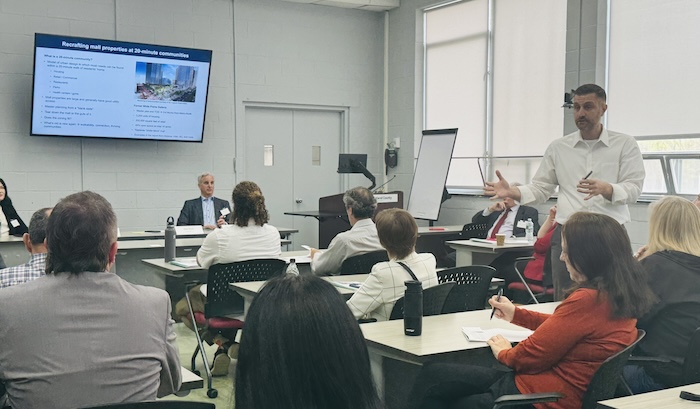Checking in with CEO of Pattern for Progress
Pattern for Progress, a nonprofit think tank based in Newburgh, is celebrating its 60th year. We spoke with Adam Bosch, its president and CEO.
How did the organization begin?
When we were founded in 1965, the Hudson Valley was going through a lot: urban renewal in city centers, people moving from New York City to suburban areas, the beginning of the environmental movement and the seeds of innovation at places like IBM in Poughkeepsie. In addition, the U.S. Army was getting ready to sell Stewart Airbase into private hands. There was a need for an objective, independent research and planning organization.
Today, we’re again in a period of rapid change. We have a housing crisis in affordability and availability. We have a new wave of technology in the form of AI and remote work, and we have generational investments being made in our downtowns, bringing small cities back to life. And the pandemic drove tens of thousands of residents into the region. Our job is to look at those things, measure them and try to explain their effects on our communities and regionwide.

What are you working on in 2025?
We’re creating community-driven plans for the reuse of buildings or parcels that have been abandoned for decades. We can set up tax credits on parcels that make them more feasible to be redeveloped as housing, mixed-use or as new manufacturing centers. The idea is to create development in our downtowns that provides progress without displacement.
With housing, there’s an indication that corporate actors are moving into the region. There’s not a lot of data, but I’ll give you my anecdotal evidence. At my house in Ulster County, I am getting two flyers per month from corporations offering to buy my house — all cash, sight unseen.
We’re going to trace these LLPs and LLCs to their common corporate owners and be able to quantify the extent of corporate homeownership and how it’s changed over the past decade. The governor has proposed that if a company owns 10 or more properties or has $50 million or more in assets, it shouldn’t be allowed to bid on a home for the first 72 hours it’s on the market. In places like Arizona, Nevada, or down to the Carolinas, there are entire neighborhoods owned by a single corporation that rents homes back to people. We want to understand the effect it has on access and the cost of homeownership.
What do you see as the most important issues facing the region?
Housing is No. 1. There’s not even a close second. We do not have enough homes to sustain the population we have, and the cost of both homeownership and rent have outpaced our growth and wages by a lot. That means housing is gobbling up more and more take-home pay.
No. 2 would be workforce. We have awesome training facilities at Dutchess Community College, Orange Community College, Marist and SUNY New Paltz, but the data show our labor pool is getting ready to shrink by about 120,000 people in the next 15 years. It’s the size of the workforce that’s a concern in the near- and medium-term, along with what I call the “youth crunch.” We have seen births — not birth rates — decline over the past two decades by about 25 percent to 35 percent in each of our counties. Dutchess is down by 25 percent. Putnam is down the most of any county. If you look at the population of infants, children and teens now and compare it to a decade ago, we have 40,000 fewer kids in the region.
After that, I would say community development in terms of: Are we able to attract and retain jobs to the region? Do they pay a living wage? The other two to mention are childcare businesses shrinking by 40 percent in 15 years and outdated water and sewer infrastructure.

The redevelopment of the former Downstate Correctional Facility in Fishkill and a transit-oriented development at the Beacon train station could add 1,600 housing units in and around Beacon. What does the community need to see from the developers?
When we did a report on the adaptive reuse of dead shopping malls, we called a lot of architects and engineers out west because they were doing more of those projects. They told us the same story over and over: They would present a development plan to the local planning board, and it would have parks, entertainment, restaurants, office space and, in one case, 1,600 housing units. Then they would come back the next month and the planning board would say, “What do we need to do to turn 1,600 units into 2,000?”
It underscored that those communities were in a growth and vibrancy mindset. They knew what the needs for housing were likely to be. But it got me thinking about our mindset in the Hudson Valley and if I had to sum it up over the past 20 years, it has been, “How do we shut it down, slow it down or cut it in half?”
If you look at our youth population and our workforce, what does it show you? Our full-time population is slowing down, shutting down and cutting in half. What I would say to communities like Beacon with projects in the pipeline is to be thoughtful about the things you need to do. Make sure there’s enough water and sewer capacity. Make sure the roads can handle the number of cars. Don’t assume the number of cars is going to be higher than it’s likely to be. The reason you’re putting housing at the train station is those people shouldn’t need vehicles. Figure out the challenges that can be overcome through sound engineering and planning.
Keep in mind that the student population of the Beacon school district, like the districts that surround it, has shrunk. Keep in mind that many of the people who will live in these developments will provide us with goods and services that we want in our communities. They might be the person who works at the grocery store or the doctor’s office or the certified nursing assistant who is going to care for your grandmother in supportive living. If we don’t build the housing, then the people who fill these jobs and, in fact, those goods and services, become harder to get.
The goal of any community needs to be to base its decisions on evidence, not feelings. It’s a tricky balance. We can see the difference in income in people moving into and out of a place and how the real-estate market has tilted away from the blue-collar, service-industry worker. The good news is there are tools that local governments can use to tilt things back, to ensure that these developments have an adequate number of units at a price point that should be affordable for local people.
It’s important to make sure our regulations require that developers set aside housing at a price point that is affordable for the local workforce, and at every level of income. I’m not only talking about the lowest of the low income. I’m talking about people like my dad, who worked at ShopRite for 48 years, or my mom, who is a medical records clerk. We want these people in our neighborhoods because they provide goods and services that we would cry and whine about if they weren’t available anymore.


If the population in need of housing includes undocumented immigrants, perhaps the demand will lessen in the foreseeable future.
This issue contains a myriad of other issues, and not many solutions trying to solve, or at least, do more than speak to it.
The cost is prohibitive in may towns to build affordable and or workforce housing. A simple opportunity for a builder to renovate a 45-year-old multi-housing project for workforce housing is met with: Cost of goods, cost of labor, cost of permitting, site and plans, zoning, and based on the inflated or even reduced cost to purchase the property, then while taking a year or so to get the project of the ground, assessed property and school taxes go up… and the ground hasn’t been broken, but the enthusiasm of creating workforce, affordable housing, becomes the perfect storm with all the costs and taxes, leaving no other alternative to go forward with anything other than market or higher then market cost rent.
Patterns for Progress is more than a think tank, they are activists for the Hudson Valley region and more. They work super closely with citizens, businesses and, most importantly, data. Not data that echoes political or corporate positioning. They care about us, and the communities we live in. So when they say “there are some actionable items,” and seek collaborators and will do the heavy lifting of solutions, to the issues, such as affordable housing, in my view, there’s no other bipartisan organization that can create a path, for people, Valley and housing, prosperity and equity. That’s been my experience.